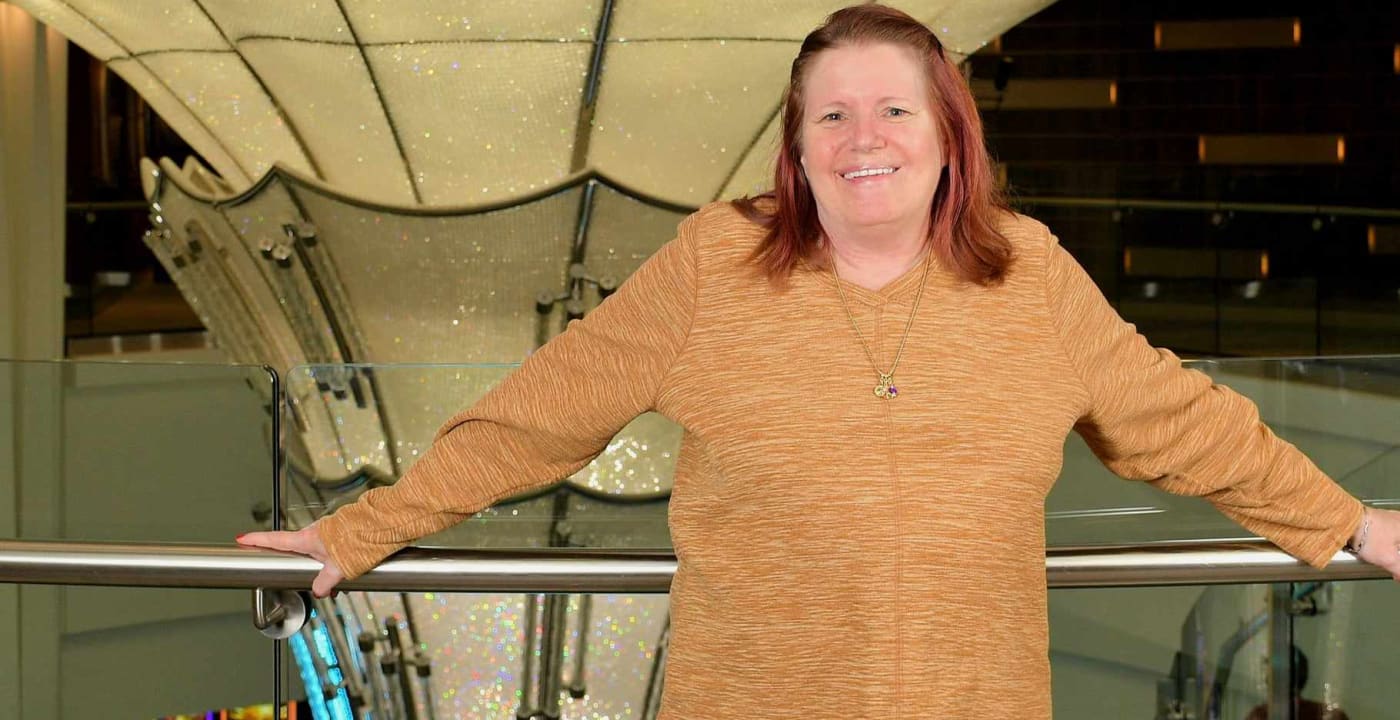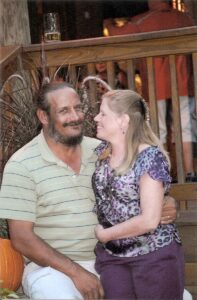Low-dose CT scan detects early-stage lung cancer in Spanaway woman

Twelve years ago, Bev Brookshire lost her husband David to lung cancer.
“He was coughing up blood, so he had a chest X-ray,” Brookshire explains. “(Doctors in Ohio) found a blood clot and put him on blood thinners. They also thought he had pneumonia.”
But months later, David’s symptoms continued, including the feeling there was a knife in his back. He got an MRI.

Brookshire with husband David
“His MRI lit up like a Christmas tree — the cancer had spread throughout his body,” she says. “He had stage 4 lung cancer.”
David was a heavy smoker, smoking up to three packs a day.
Brookshire, 63, smoked a pack a day regularly for around 22 years, but quit about seven years ago.
Paying attention to symptoms
When she developed symptoms that weren’t going away, Brookshire made sure to see her doctor.
“I was very short of breath. I had a bit of wheezing. I wasn’t keeping up like I used to,” she shares. “I felt like something was going on.”
Brookshire, who now lives in Spanaway, Washington, was referred to MultiCare pulmonologist Venkat Rajasurya, MD.
Because of her smoking history and symptoms, Dr. Rajasurya recommended a low-dose CT scan to screen for lung cancer.
The scan, in February of this year, revealed a 7mm nodule on her left lung. She and Dr. Rajasurya agreed to repeat the scan in three months to see if its size stayed the same.
Her follow-up CT scan in May showed the lesion had grown to 9mm.
“Bev was fortunate to have Dr. Rajasurya in her corner,” shares MultiCare cardiothoracic surgeon Baiya Krishnadasan, MD. “He did not wait long to reimage the nodule, and when it grew, he immediately sent her my way to discuss next steps.”
Advanced procedure ensures accurate diagnosis
“I was scheduled for a biopsy, but I have bad scoliosis,” Brookshire says. “They tried to go through my ribs on the outside, but because of my scoliosis, my ribs are squished together in a weird way.”
She was then referred to MultiCare interventional pulmonologist Abhishek Biswas, MD, as he’s trained to perform advanced procedures for cases like Brookshire’s.
“Bev has significant kyphoscoliosis (curvature of the spine that’s both sideways and forward/backward), which made the biopsy challenging,” Dr. Biswas explains. “The only way to do the biopsy was with robotic-navigation bronchoscopy with cone-beam, real-time imaging.”
Bronchoscopy, or transbronchial biopsy, is a minimally invasive procedure where a thin tube is guided down the throat to the lungs. Dr. Biswas successfully reached the area of concern with this approach.
The biopsy revealed Brookshire had stage 1 non-small cell lung cancer.
After her diagnosis, she says her treatment began to move quickly, and surgery was scheduled with Dr. Krishnadasan (Dr. “K”) to remove the lower left part of her lung.
“Everyone told me Dr. K was the best of the best. That helped a lot in making me feel more comfortable. Dr. K and Dr. Biswas get my full praise. In fact, everyone at MultiCare was wonderful throughout the whole process.”
“The multidisciplinary team approach at MultiCare not only improves timely diagnosis and accurate staging, but also shortens the time to receive treatment,” Dr. Rajasurya says. “This is particularly important in lung cancer management, as it improves patient outcomes, especially overall survival for all stages of cancer.”
When her husband was diagnosed with lung cancer, his lung tumor was already the size of a baseball. She says she feels lucky hers was caught early.
“I was like, ‘Let’s do this,’ but I was also scared. I won’t deny it,” she admits. “The whole team put me at ease. Everyone told me Dr. K was the best of the best. That helped a lot in making me feel more comfortable. Dr. K and Dr. Biswas get my full praise. In fact, everyone at MultiCare was wonderful throughout the whole process.”
Brookshire was able to see her granddaughter before surgery, and her daughter sat in the pre-op area with her and held her hand.
“I was glad to have family support before I had to go under,” she says. “I was very scared going through this because my husband had passed (from lung cancer).”
Celebrating being cancer-free on an Alaskan cruise
Brookshire’s surgery and recovery went well, and her symptoms improved almost immediately.
“We were able to remove Bev’s tumor minimally invasively,” Dr. Krishnadasan says. “She spent less than a day in the hospital and was discharged home on a little oxygen. She was off oxygen within a week and able to travel for a long-awaited family trip.”
Two weeks after surgery, Brookshire and her daughter Ginnett went on an Alaskan cruise.

Brookshire and daughter Ginnett on their Alaskan cruise
“We walked all over that ship,” she recalls. “We went dancing, we went into port and walked around. I still got a little short of breath going up steps, but otherwise I was able to keep up.”
Her last CT scan was clear, and she doesn’t have to undergo chemotherapy or radiation.
“Because she was diagnosed in the earliest stage, it gives us the highest chance of cure and lowest chance of recurrence in five years,” adds Dr. Biswas.
Low-dose CT scans are a relatively recent lung cancer screening measure. The U.S. Preventive Services Task Force began recommending the screenings in late 2013 — more than a year after Brookshire’s husband passed away.
“My husband was good about going to the doctor for checkups, and he got X-rays of his lungs every year because of his smoking,” Brookshire says. “But his tumor didn’t show up on X-rays. If he could have done a CT scan, he would have, and he would still be here.”
She adds, “I tell everybody I know, ‘If you’re a smoker or former smoker, get a CT scan.’ Better safe than sorry.”
What's next
- Who’s eligible for a lung cancer screening, and how is it performed?
- If you’re over 50 with at least a 20 pack-year history, schedule an appointment with your provider
- Lung cancer prevention and screening at MultiCare



